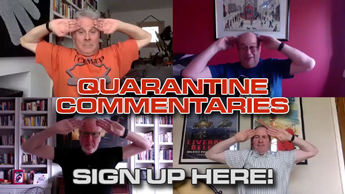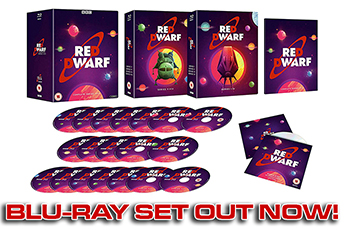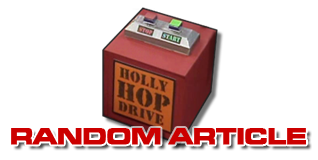Complete Guide
Effects
Every series of Red Dwarf is the most effects-intensive until the next one, and VI was no exception. The model shots required were more complex and more numerous - and time was pressing. Peter Wragg's team elected to shoot a number of Starbug shots against bluescreen to allow more flexibility in the edit, and all other shots were done 'complete' - there would be no matting of individual elements this time. In 23 days, around 140 effects shots were filmed.

Despite the short production period, the team initially attempted an unrequested shot that had been much talked about in previous seasons - the crew viewed through Starbug's window. A reflected rear-projection image of the crew in the Starbug cockpit set was played into the miniature Bug model, and - despite a wobble caused by a faulty projector - the result was quite impressive. (Sadly, the shot did not make it into the finished Psirens show - and costume continuity meant that it couldn't be used in a different episode.)
Psirens - with its asteroid belt - was likened by the crew to a sequence in The Empire Strikes Back (where Industrial Light and Magic had six months to put the Millennium Falcon through hell, BBC FX had three days!). Aside from one unfortunate moment where Pete Tyler cut the wrong wire - causing asteroids and models to crash to the floor - the shoot went well. Mike Tucker built a spacecraft interior through which the scouter (seen last series) could float, and scores of derelict ships were scattered through deep space - including models from Space 1999, Alien and others!

Having dropped a flaming meteorite on the Bug from above, the large-scale Starbug model was crashed. A massive Bug leg was built for a scene showing Lister blasting away rock. A bug model was placed in the foreground close to camera, giving the impression that the leg was attached to the rest of the ship.
Legion's magnificent space station was constructed by Nick Kool, while the interior was built by Mike Tucker. The tractor beam was added in post-production by Terry Hylton and Karl Mooney at SVC Television - who provided the video effects for the series. SVC had been predominantly active in commercials and, looking to get into TV shows, did Grant Naylor a deal that meant they got masses of effects at low cost.
These shots ranged from Legion's morphed face and tractor beam to the shot of the star drive crashing through Starbug's hull. The model version of this effect hadn't quite worked, so a composite of a new stock model shot, star drive footage and a computer-generated explosion was used instead.
Indeed, explosions became the most common effect for SVC with laser blasts flying thick and fast (note the shadows and light that touch the characters when they fire, too). Using Quantel's HARRY machine, Rimmer's hologram downloaded (complete with a 'little finger' charisma graphic that expanded greatly on the script's description), anti-matter chopsticks glowed, Dwarfers teleported, Legion's whirlwind swirled and the spayed Polymorph, well, morphed.

SVC also added 3D flies to shots of Pestilence and made the organic-looking wipe that flooded the Armageddon Virus into Kryten's system. (Rob and Doug had insisted on this type of effect, although had SVC wanted to include signs of the virus permanently on Kryten's body.) Additionally, a whip was painted onto one shot during the bar fight and a morph was performed to transform Kryten's guns into doves. The company also utilised whipped-up cloud images to create the massive wormhole for Rimmerworld, which was also used in the title sequence.
The most bizarrely effective video effect, however, came from Andy deEmmony's reinvention of a Red Dwarf standard - the split screen. Andy's son leant the production a video painter which allowed the split to occur at curves and angles rather than the conventional (and, by now, obvious) straight line. This allowed for the dual Listers of Psirens, the many Rimmers on Rimmerworld and the older crew in Out of Time (the latter featuring a Kryten double in the form of Tim English).
Back on the model unit, the lack of matting meant that Starbug's tractor beam capture in Legion and encounter with itself in Out of Time had to be done all for real, in one uncomposited shot - against a brand new back cloth that, for the first time, featured coloured nebulae. (The cloth would later have a hole cut in it and a lamp shone through to provide a 'sun' for the very first shot of the new season.)

The simulant ship was blown up in two stages for its two episodes. Designed to look like a cow's skull (keeping with the Western theme), a 'horn' was blown off first (in a sequence where the movement of Starbug, it was felt, could almost have featured a tyre screech!) then the whole thing was blasted.
As the Bug dove for the lava planet - a replacement for the scripted ocean moon which was rejected because water refuses to scale well in miniature (note the reference to this that remains in Rimmerworld) - the camera was mounted on the Bug's back. An oval glass sphere covered in spray glue and lit from within became the planet on the double-exposed film reel.
The smallest Starbug model was used for the lava crash - although, thanks to a hidden hole in the set-up, it didn't actually touch the lava at all. (It did, however, hit the 'mountains' and split painfully in two on the first take!) The lava (complete with food thickener) filled a perspex base and was augmented with black as made from foil, cork and rubber dust. Jets of flame were also used but, when they proved ineffective, bubbles were blown into the pool instead.
The planet's atmospheric background was constructed from three 10" by 8" sunset backdrops, formerly used on 2001. For the final shot, over which the credits roll, the camera was moved to create the effect of rolling clouds.
On Emohawk, another Starbug crash - in a swap whose surrounding grassfields were made from green teddy-bear fur! - allowed tiny versions of the crew to ride in a miniature dinghy. The crash itself, with the large Bug model, managed to soak Peters Wragg and Tyler. But even on set it can be dangerous, and the explosion in the cockpit left Danny John-Jules with welts in his cheek.
Rimmerworld's escape pod model (nicknamed the Clogg) proved almost lethal when it dropped thirty feet from its rig towards Pete Tyler, who was behind the camera, missing him by inches. But, with typical irony, it was a non-model model effect that had the biggest impact on screen as Starbug was destroyed at the end of the final episode.
With the last minute decision to destroy Starbug, there was neither time nor money to do it for real. (The edit had lasted well beyond production and the effects team were working on other projects.) The effect was done with video trickery, putting explosions together with existing Starbug footage, with some additional wreckage provided courtesy of SVC.

On the set, physical effects were just as numerous - although one proved unnecessary. Danny, it turns out, is quite adept at gun-twirling and had no need of the special rig that had been made for him! But at least one accidental effect influenced the script when it was revealed that, in previous weeks, the Cat's seat really had squeaked.
Propbusting remained a popular, if somewhat accidental game with Craig lifting the sink from its place in the galley to turn it into an impromptu helmet (with the tap as a radio microphone). Robert, meanwhile, dropped and broke the first light-bee - not a problem in a show when spares were already more of a necessity than a luxury.
Once again, a number of the usual effects suspects were in. Reverse photography allowed an arrow to be fired into a trunk (with the Dwarfers who carried it walking backwards) and Lister to throw knives at his would-be assailant. And a spring-loaded spear made it appear that serious damage was being done to Pete Tranter's sister.
More eerily, some of Lister's body parts were also built up - including his stomach (moulded from Mike Tucker's own belly in gelatine) to be sliced open on cue, and an arm which had to be packed with circuitry. Lister's brain, meanwhile, developed an unfortunate tendency to float - although the organ, which flashed in time with its dialogue, was eventually held in place.

Then came the rubber. The psiren - a big, stag-beetle based creature, coated in KY jelly (not hugely fun for Craig to kiss, even with former curry monster Paul McGuinness inside) - was followed by the Emohawk. Four of the shape-shifters was built including one that resided in a bean tin, and another that would fit on Lister's head (the underside was marked 'sweaty' in marker pen). Sadly the 'flying' creature was nothing of the kind - and as it was sent into the heavens by the GELF chief, it simply plopped rather limply to the ground off-camera.

Physical props included the usual bazookoids (now modified to fire four times rather than once) and psi-scan (a new version, complete with an in-joke from its maker 'Tucker Instruments'). The psi-scan also featured a fully-functional LCD screen, which was sadly never shown. New guns were introduced for Dwarfers and villains, including a simulant gun rebuilt from the Dr Who story Earthshock and a small weapon by Alan Marshall which was nick-named the Bazooket.
To whack Rimmer over the head, breakable vases were made, as well as a lightweight silver tray, wooden post and - for Kryten - the Existence town sign. A fibreglass cocoon was recycled from Alexi Sayle's show to provide Rimmerworld with its first inhabitant and AR helmets were adapted from Hyperland's devices. And carbon dioxide canisters were borrowed from the Shepperton fire service when the supply on set rapidly ran out. Finally, there were doves carved on Kryten's gun handles... but the camera never saw them.














